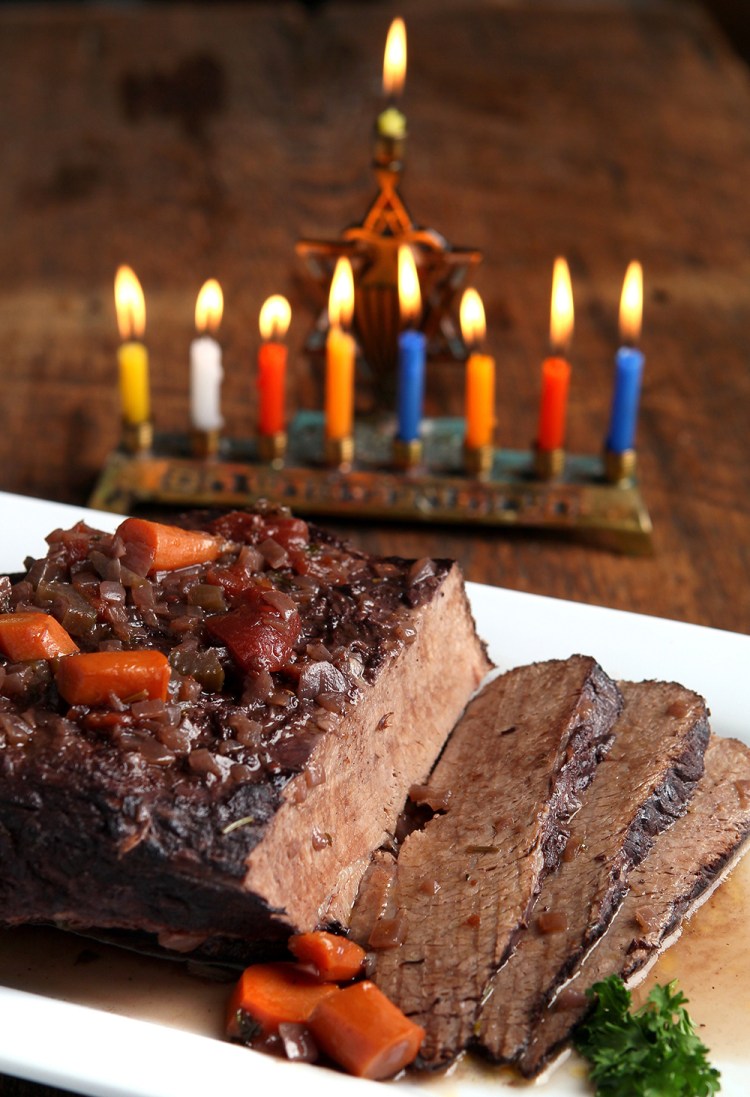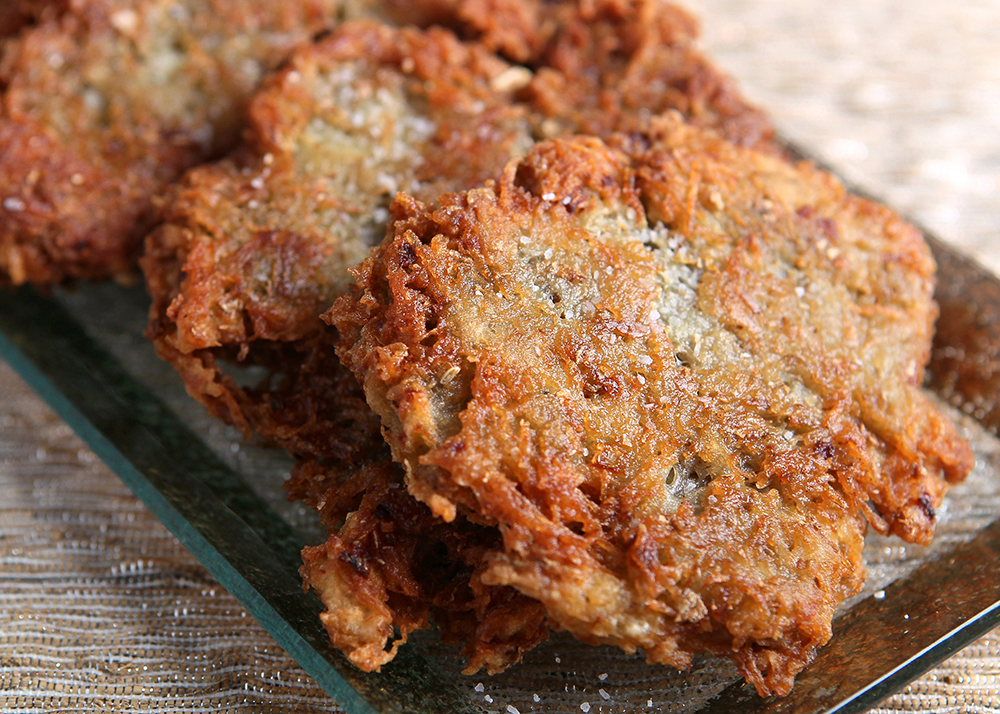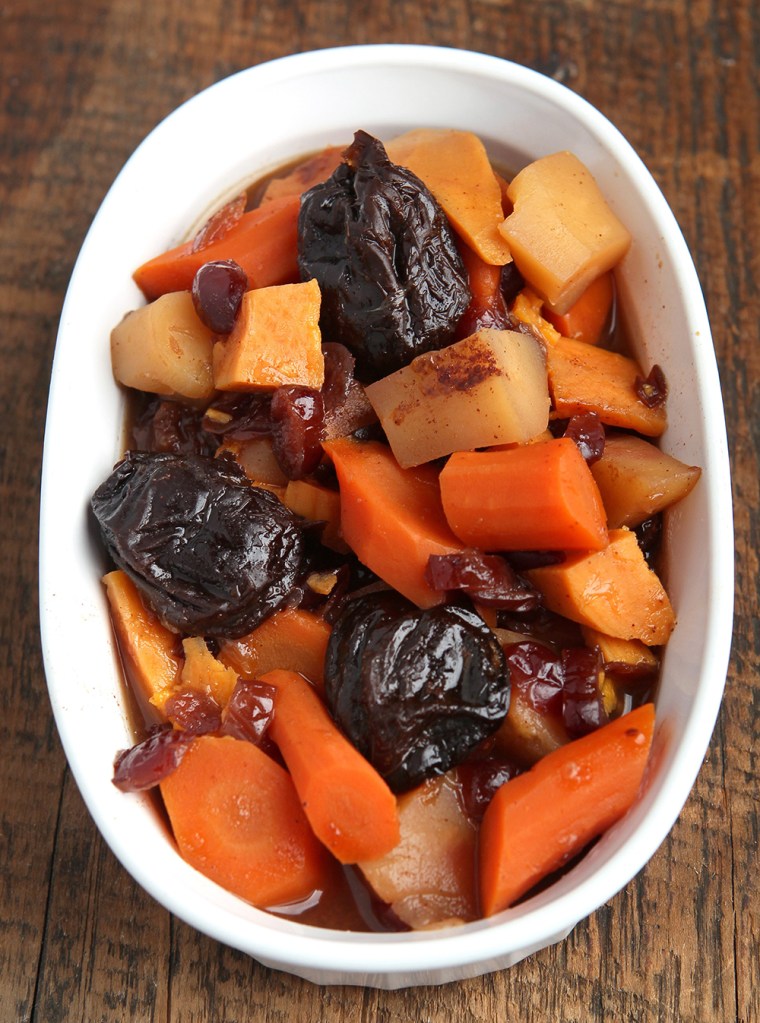It’s all a matter of cause and effect.
The cause is that in 164 BC, a group of Jews led by Judah Maccabee captured the former Jewish Temple in Jerusalem, which had been turned into a pagan shrine by brutal King Antiochus IV.
The effect is that Jews today eat latkes for Hanukkah.
Latkes — potato pancakes — are a delicious reminder of the Hanukkah story. The story is that when the Jewish warriors made their way into the desecrated Temple, they found only enough oil to light the eternal flame for one day.
But the flame miraculously burned for the eight full days that were needed to secure more oil. And this miracle, which is now at the center of the Hanukkah celebration, is commemorated by eating food fried in oil, specifically latkes.
That makes sense. Any excuse to eat latkes is a good one, and an oil-based miracle is better than most.
But a lot of Jews also eat brisket on Hanukkah and, to be fair, most other religious holidays. Why is there a tradition of eating celebratory brisket?
I have done a fair amount of research into this very question, and I have uncovered what appears to be the two main reasons for the holiday tradition:
1. It’s cheap.
2. It’s good.
Most American Jews trace their families back to Eastern Europe where, as a people, they were generally quite poor. As is the case with all poor communities, they could not afford to eat the best, most tender, cuts of meat. So they ate what they could, the tougher meats that needed to cook at low temperatures for hours before they could be served. Shanks and chuck roasts were popular, and so was the marvelously flavorful brisket.
Brisket is particularly suited to being cooked with a wide variety of ingredients because, although it has a distinctive flavor of its own, it also easily absorbs the taste of the other ingredients in the pot. You can cook it in a tomato sauce or in beer, in a sweet-and-sour sauce or even with sauerkraut. You can use it in Korean barbecue or turn it into a Scandinavian soup using Akvavit, a liquor flavored with caraway or anise.
Any way you make it, it is going to be good. The collagen and fat that are marbled throughout the cut slowly melt in long, low cooking, and they flavor and moisten the meat and give it its richness.
So for our Hanukkah meal, we have a traditional entree and a traditional starch. All we need is a traditional vegetable dish.
Unfortunately, there really isn’t one for Hanukkah. (The eight-day holiday begins Tuesday night.) So I decided to make tzimmes, a dish of sweet, stewed root vegetables and dried fruit often served at Rosh Hashanah (the New Year) but suitable for any meal in the fall and winter. Like brisket, tzimmes was especially popular in the Old Country, whichever old country in Eastern Europe that happened to be. And also like brisket, there are as many different ways to make it as there people who cook it.
I decided to go with a stove-top version, because my oven would be taken up with a brisket.
What makes this tzimmes so delicious is the mixture in which it is cooked. Orange juice, honey, brown sugar, cinnamon and chicken stock give a luscious sweetness to the already sweet-but-earthy root vegetables, in this case carrots, sweet potatoes and parsnips. The whole thing is then topped with dried cranberries and prunes and cooked until perfectly tender.
You don’t like prunes, you say? Try them in tzimmes. Seriously, try them.
The brisket is cooked in much the same way as the tzimmes, in liquid at a low temperature for a long time. The liquid in this case is primarily red wine, but it also benefits from a can of tomatoes. More onions than you would think go into the mix as well, along with celery and, eventually, carrots. A dash of thyme, a smidgen of rosemary and a bay leaf are also added to the pot, which gently simmers for 3 1/2 hours until the flavors are beautifully melded and the meat is so tender you can cut it with a table knife.
Which brings us to the latkes. I am picky about my potato pancakes — I like them crispy, with only a little onion mixed in and virtually nothing else, other than a hint of nutmeg. I have always thought that people who pollute their potato pancakes with baking powder are thinking too literally about the word “pancakes.” All I need, besides the potato, onion, and hint of nutmeg are an egg or two and a light sprinkling of flour to hold it together while it fries.
The latkes that result are nothing short of a Hanukkah miracle.
NOT TOO WELL STEWED BRISKET
2 teaspoons salt
Freshly ground black pepper
1 (5-pound) brisket of beef, shoulder roast of beef, chuck roast or end of steak
1 clove garlic, peeled
2 tablespoon vegetable oil
2 onions, peeled and diced
1 (14-ounce) can tomatoes
2 cups red wine
2 stalks celery with the leaves, chopped
1 bay leaf
1/2 teaspoon dried thyme
1/2 teaspoon dried rosemary
1/4 cup chopped parsley
1 pound carrots, peeled and sliced on the diagonal
Note: The original English-Yiddish name of this dish is Not Too Gedempte Fleysch.
Preheat the oven to 325 degrees. Sprinkle the salt and pepper to taste over the brisket and rub with the garlic. In a large skillet or pan, heat the oil over medium high and sear the brisket on both sides. Put the onions in a large Dutch oven or casserole and place the brisket on top of them, fat-side up. Cover with the tomatoes, red wine, celery, bay leaf, thyme and rosemary.
Cover and bake about 3 hours, basting often with the pan juices.
Add parsley and carrots and bake, uncovered, for 30 minutes more, or until carrots are cooked and meat is fork-tender (when you put a fork in the meat and pull it out, there should be a light pull on the fork as you remove it).
This dish is best when it is prepared a day ahead of time and refrigerated, so the fat can easily be skimmed from the surface. When ready to serve, remove the layer of fat from the top and replace in the pot with the side that had been covered by the fat facing down. Spoon some gravy over the top and reheat over medium heat or in the oven at 350 degrees until the meat is heated through, about 30 minutes.
Per serving: 641 calories; 43 g fat; 16 g saturated fat; 152 mg cholesterol; 43 g protein; 9 g carbohydrate; 4 g sugar; 2 g fiber; 615 mg sodium; 46 mg calcium.
Recipe adapted from a recipe originally by Joan Nathan and reprinted in “The Brisket Book” by Stephanie Pierson.
STOVETOP TZIMMES
Yield: 8 servings
2 sweet potatoes, peeled and cut into 1- to 2-inch pieces
2 large parsnips, peeled and cut into 1- to 2-inch pieces
1 pound carrots, peeled and cut into 1-inch rounds
5 ounces dried cranberries
2 cups orange juice
1/2 cup honey
1/2 cup brown sugar
2 teaspoons cinnamon
1 teaspoon salt
1/2 teaspoon black pepper
1 1/2 cups chicken broth or salted water
10 ounces pitted prunes (2 1/2 cups)
Mix together sweet potatoes, parsnips and carrots in the bottom of a large, heavy pot. Sprinkle dried cranberries on top.
In a medium bowl, thoroughly whisk together orange juice, honey, brown sugar, cinnamon, salt and black pepper. Pour mixture over fruit and vegetables in the pot.
Add chicken broth or salted water. Heat pot over medium high until it begins to simmer, stirring once. Reduce heat to a gentle but constant simmer, and cover the pot.
After 45 minutes, gently stir again. Place pitted prunes on top of the other ingredients and replace the cover.
Cook on lowest heat for 15 minutes until sweet potato pieces are tender and prunes have warmed and softened. Avoid overcooking, which will cause the prunes to dissolve.
Per serving: 367 calories; 1 g fat; no saturated fat; no cholesterol; 3 g protein; 92 g carbohydrate; 64 g sugar; 7 g fiber; 523 mg sodium; 65 mg calcium.
Adapted from a recipe by Tori Avey.
LATKES
Yield: 5 servings
2 russet potatoes, unpeeled
2 tablespoons onion, minced
1 large wedge lemon
2 eggs, lightly beaten
2 tablespoons all-purpose flour
1/4 teaspoon nutmeg
Vegetable oil (not olive)
Grate the potatoes, using the small holes of a grater. Place the gratings in several layers of paper towels and squeeze out as much liquid as you can (it is easiest to do this in 2 batches, and it makes cleaning easier if you do it over a sink). Unwrap the potato gratings and place them in a medium bowl. Add the onion, squeeze the lemon over the top and mix thoroughly. Add the eggs, flour and nutmeg, and stir to mix again.
Pour oil into a skillet to a depth of 1/8 to 1/4 inch. Heat the oil over medium-high heat until it is very hot; the oil is ready when a little bit of the potato mixture instantly sizzles when you drop it in. Pour in enough of the potato mixture to make 1 or 2 (4-inch) pancakes; do not make more than 2 at a time. Flatten the potatoes in the pan with a spatula and fry a few minutes until the bottom is golden brown. Flip pancakes and cook until the other sides are golden brown. Remove, drain on paper towels sprinkle with plenty of salt.
If desired, serve with apple sauce or sour cream.
Per serving: 200 calories; 7 g fat; 1 g saturated fat; 74 mg cholesterol; 6 g protein; 30 g carbohydrate; 1 g sugar; 2 g fiber; 36 mg sodium; 33 mg calcium.
Recipe by Daniel Neman
Send questions/comments to the editors.





Success. Please wait for the page to reload. If the page does not reload within 5 seconds, please refresh the page.
Enter your email and password to access comments.
Hi, to comment on stories you must . This profile is in addition to your subscription and website login.
Already have a commenting profile? .
Invalid username/password.
Please check your email to confirm and complete your registration.
Only subscribers are eligible to post comments. Please subscribe or login first for digital access. Here’s why.
Use the form below to reset your password. When you've submitted your account email, we will send an email with a reset code.